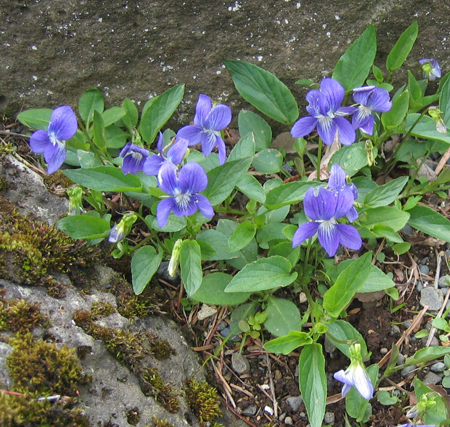Viola canina L.
Common names:
Heath Dog Violet
Synonyms:
Viola canina L., Sp. pl., ed. 1, 2: 935. 1753. TYPE: "Habitat in Europae apricis" (lectotype designated by Nikitin, Bot. Zhurn. 80(7): 93. 1995: Herb. Linn. No. 277 (LAPP)).
Viola nemoralis Kuetz., Linnaea 7(1): 46. 1832
Description:
Caulescent perennials from somewhat slender rhizome, stems ascending in flower, ≤ 30 cm tall; stems, foliage and peduncles deep green to gray-green, glabrous except for scattered short appressed hairs on upper and/or lower surfaces of leaf blades; leaves cauline only, cauline distributed along stem; stipules free, subentire or minutely toothed to shallowly lacerate; leaves ascending or spreading, leaf blades undivided, largest ≤ 52 × 27 mm, narrowly ovate to oblong-ovate, base truncate to cordate, margins crenate, eciliate, apex acute to narrrowly obtuse; chasmogamous flower ≤ 17 mm; calyx glabrous, eciliate; lowest sepals lanceolate, acuminate; auricles short and entire, not elongating in fruit; corolla blue-violet to gray-violet and white at base, throat white; spur moderately elongate, slender, light yellow to light green; lateral petals densely bearded with narrowly linear hairs, spurred petal glabrous; cleistogamous flowers produced after chasmogamous; capsule 7–9 mm, green drying tan, unspotted or with fine red spots or lines, glabrous; seeds 1.7–2.1 × 1.0–1.3 mm, light to dark brown, unspotted; 2n=40.
Similar species:
This species is immediately separable from our other rostrate violets in lacking basal leaves and in the shorter light yellow to light green spur. It differs from Viola adunca in its glabrous or sparsely hirtellous leaves, subentire to minutely toothed or weakly lacerate stipules, and shorter spur. It is distinct from V. labradorica in lacking basal leaves, sometimes subentire or minutely toothed stipules, distinctly longer than broad cauline leaf blades, and blades sometimes sparsely hirtellous on the lower surface.
Ecology:
Dry or slightly moist sand or gravel of tundra and slopes.
Distribution:
S. and w. GL, Iceland, Eurasia. Marcussen and Karlsson (2010) suggested that this species may be introduced in Greenland, but no evidence was given to support this conjecture. Jørgensen et al. (1958) evidently accepted it as a native species.
Rarity:
None.
Phenology:
Chasmogamous flower May-July, chasmogamous and cleistogamous fruit presumably June and later.
Affinities:
This species belongs to the Rostrate Violet lineage, sect. Viola, subsect. Rostratae (Kupffer.) W.Becker.
Hybrids:
None (in our region).
Comments:
Brainerd (1921b), Brainerd Baird (1942), Fernald (1950), Alexander (1963), Russell (1965), and Gleason and Cronquist (1991) made no mention of this species. Jørgensen et al. (1958), Scoggan (1978), and Little and McKinney (2015) included it. The description is adapted from Marcussen and Karlsson (2010), and the ecology is adapted from Scoggan (1978). Jørgensen et al. (1958) referred Greenland plants to subsp. montana (L.) Fr., although they noted that all material more closely resembled subsp. canina in smaller stature, procumbent stems, and narrower stipules. Marcussen and Karlsson noted an earlier morphometric study documenting greater morphological variation in V. canina in Norway than previously realized and failing to distinguish the two subspecies, as well as an ecophysiological study inducing morphological traits of subsp. montana in typical subsp. canina by manipulation of moisture, light and nutrient conditions. Marcussen and Karlsson's recommendation to abandon such infraspecific taxa in V. canina is adopted here.
Literature Cited:
Alexander, E. J. 1963. Violaceae. In Gleason, H. A., The new Britton and Brown illustrated flora of the northeastern United States and adjacent Canada. Hafner Publishing Co., Inc., New York, NY. 552-567.
Brainerd, E. 1921b. Violets of North America. Vermont Agricultural Experiment Station Bulletin 224: 1–172.
Brainerd Baird, V. 1942. Wild violets of North America. University of California Press, Berkeley, CA.
Fernald, M. L. 1950. Violaceae. In Gray’s Manual of Botany, 8th ed. American Book Company, New York, NY. 1022-1042.
Gleason, H. A., and A. Cronquist. 1991. Violaceae. In Manual of vascular plants of northeastern United States and adjacent Canada, 2nd ed. New York Botanical Garden, Bronx, NY. 157-163.
Jørgensen, C. A., T. Sørensen, and M. Westergaard. 1958. The flowering plants of Greenland–A taxonomical and cytological survey. Biol. Skr. 9(4): 1-172.
Little, R. J., and L. E. McKinney. 2015. Violaceae. In Flora of North America: Cucurbitaceae to Droseraceae, 106. Oxford University Press, New York, NY.
Marcussen, T., and T. Karlsson (eds.). 2010. Violaceae. Flora Nordica 6: 12-52.
Russell, N. H. 1965. Violets (Viola) of the central and eastern United States: An introductory survey. Sida 2: 1–113.
Scoggan, H. J. 1978. Violaceae. In Flora of Canada, Part 3–Dicotyledoneae (Saururaceae to Violaceae). National Museums of Canada. Ottawa, Canada. 1103-1115.

Chasmogamous flowering habit by Salvor Gissurardottir, "Useful Temperate Plants" website, under Creative Commons License 3.0